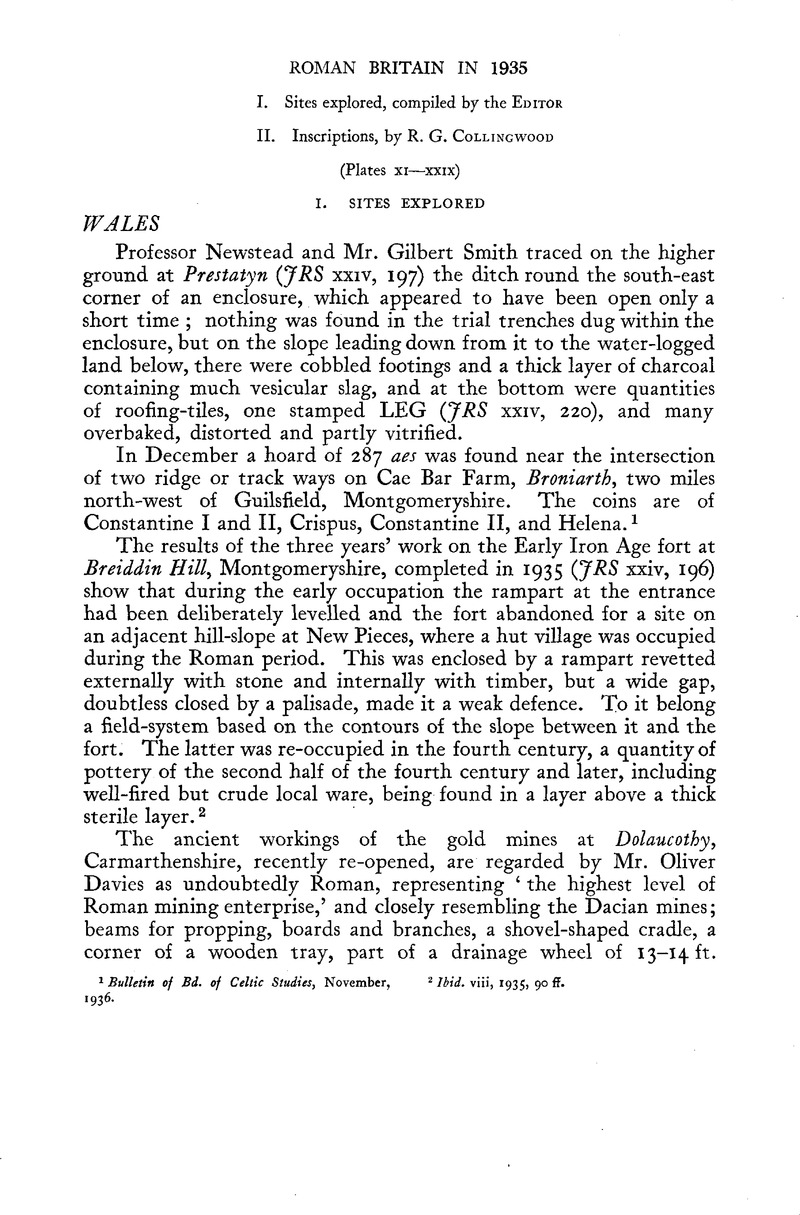No CrossRef data available.
Published online by Cambridge University Press: 24 September 2012

1 Bulletin of Bd. of Celtic Studies, November, 1936.
2 Bulletin of Bd. of Celtic Studies, viii, 1935, 90 ff.
3 Arch. Cambrensis xci, 51.
4 Proc. Soc. of Antiqs. Newc., Ser. 4, vii, 107 ff.
5 Proc. Soc. of Antiqs. Newc. vii, 50 ff., and Arch. Ael. 4 xiii, 117.
6 Arch. Ael. 4 xiii, 218–42.
7 Antiqs. Journ. xvi, pl. xxiii, 1.
8 Principia, Arch. Ael. 4 xiii, 221–33; Samian ware, Antiqs. Journ. 242–57.
9 Antiqs. Journ. 258–73, a comprehensive article. For the gateway types see Arch. Ael. 4 xii, 36.
10 CIL vii, 661, 662, 663; the provenience of no. 660 is doubtful.
11 CIL vii, 835.
12 Cumb. and Westm. Arch. Soc. Trans. 2 xxxvi, 158–170.
13 Cumb. and Westm. Arch. Soc. Trans. 172–9.
14 Cumb. and Westm. Arch. Soc. Trans. 170–72.
15 Cumb. and Westm. Arch. Soc. Trans. 183–4.
16 Cumb. and Westm. Arch. Soc. Trans. 182–91.
17 Cumb. and Westm. Arch. Soc. Trans. 179–82.
18 Arch. Ael. 4 xiii, 199–205.
19 Arch. Ael. 170–84.
19A Arch. Ael. 184–196.
20 Information from Mr. Philip Corder, who says that the only objects found were potsherds and two trumpet-brooches of Collingwood, Archaeology of Roman Britain, type R ii and iv.
21 Numis. Chron. xv, 202 ff. The coins are now in Doncaster Museum, the other objects in the possession of Lord Fitzwilliam.
22 Corder, and Romans, , Excavation at the Roman town at Brough, E. Yorkshire, 1935 (E. Riding Antiq. Soc., Hull, 1936, 1s. 6d.)Google Scholar.
22A Yorks. Arch. Journ. xxxiii, 81 ff.
23 Professor Donald Atkinson thinks that this is published in Annals of Arch. and Anthrop. xxiii, may be so at some period in its history. The report 12 ff.
24 Annals of Arch. and Anthrop. xv, 4, pl. ii, and xviii, 6, pl. vii.
25 Information from Mr. Mossop, to whom we are indebted for the plan shown in fig. 25.
26 Antiquity x, 94, pl. iii; it should be compared with the piece published by Smith, C. R., Coll. Antiq. iv, 90, pl. xxivGoogle Scholar (hence Haverfield, F., Romanisation of Roman Britain (1922), p. 51Google Scholar), which shows Hercules and the chained Hesione.
27 Antiquity x, 468.
28 Camb. Antiq. Soc. Proc. xxxvi, 109 ff., pl. i–x.
29 As one at the NE corner opened in 1846, Meeting of Arch. Inst. at Norwich 1847 (1851), p. 11 ff.Google Scholar
30 Antiqs. Journ. xvi, 444.
31 Information from Mr. Rumbelow, the owner of the objects shown (fig. 27), who has preserved a beautifully illustrated record of his discoveries. Robertson, A. in Numis. Chron. xvi, 164 ff.Google Scholar
32 An explanation of this pendant is given by Mr. Smith, R. A. in Soc. Antiqs. Proc. xxx, 54–62Google Scholar; the type shown in fig. 27 seems to be confined to east Britain; for the handle, cf. the bronze tubes in Wroxeter 1914 Report, pl. xxi, fig. 2, nos. 7, 8, where they are compared to some ferrules found at Hofheim.
33 JRS XXII, 39, 46, fig. 6.
34 Suffolk Arch. Inst. Proc. xxii, 178 f. The kiln and pots are now in Ipswich Museum.
35 R. P. Hinks in British Museum Quarterly ix, 139; we are indebted to the Trustees of the British Museum for pl. XXI.
36 RHMC, Roman London, p. 99, no. 2.
37 Antiqs. Journ. xvi, 1.
38 A. Robertson, Numis. Chron. xvi, 156 ff.
39 Information from Mr. Hodgkinson and Mr. J. K. St. Joseph. The Report is to appear in the Birmingham Arch. Soc. Trans., vol. lviii.
40 The most notable small object was the terret chased in relief and decorated with red enamel, dated to the first century A.D. (pl. xi, 2).
41 Oxoniensia i, 24; cf. Antiquity iv, 1930, 303.
42 Numis. Chron. xvi, 251 ff.
43 Records of Bucks xiii, 1936, 191 ff.Google Scholar The pottery is now in Aylesbury Museum.
44 Not SE, as in JRS xxv, 212.
45 St. Albans and Herts Archit. and Arch. Soc. Trans. 1935, 312 ff.
45A Ibid. p. 243 ff. and see infra p. 267.
46 We owe this information to Mr. M. R. Hull; cf. VCH Herts iv, 150.
47 Bristol and Glos. Arch. Soc. Trans. lvii, 260.
48 Numis. Chron. 1936, p. 250.
49 Antiqs. Journ. xvi, 206, 323, where it is compared with one slightly less crude found at Camerton, Somerset.
50 Information from Mr. W. A. Smallcombe, who is publishing the pottery in full. The plan shown in fig. 30 we owe to Mr. Harris.
51 Williams-Freeman, , Field Archaeology of Hampshire (1915), pp. 285, 398 (plan)Google Scholar.
52 Surrey Arch. Collec. xliv, 84.
53 Ibid. xliv, 140; this piece has been turfed and preserved as an ancient monument.
54 Antiqs. Journ. xvi, 149 ff.
55 Arch. Cantiana xlvii, 240.